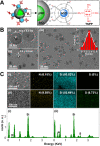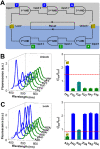An optical keypad lock with high resettability based on a quantum dot-porphyrin FRET nanodevice
- PMID: 37260500
- PMCID: PMC10228340
- DOI: 10.1039/d3na00030c
An optical keypad lock with high resettability based on a quantum dot-porphyrin FRET nanodevice
Abstract
Due to their appealing properties, nanomaterials have become ideal candidates for the implementation of computing systems. Herein, an optical keypad lock based on a Förster resonance energy transfer (FRET) nanodevice is developed. The nanodevice is composed of a green-emission quantum dot with a thick silica shell (gQD@SiO2) and peripheric blue-emission quantum dots with ultrathin silica spacer (bQD@SiO2), on which 5,10,15,20-tetrakis(4-sulfophenyl)porphyrin (TSPP) is covalently linked. The nanodevice outputs dual emission-based ratiometric fluorescence, depending on the FRET efficiency of bQD-porphyrin pairs, which is highly sensitive to the metalation of TSPP: values are 59.7%, 44.8%, and 10.1% for bQD-Zn(ii)TSPP, bQD-TSPP, and bQD-Fe(iii)TSPP pairs, respectively. As such, by using the competitive chelation-induced transmetalation of TSPP, the nanodevice is capable of implementing a 3-input keypad lock that is unlocked only by the correct input order of Zn(ii) chelator, iron ions, and UV light. Interestingly, the reversible transmetalation of TSPP permits the reset (lock) operation of the keypad lock with the correct input order of ascorbic acid, Zn(ii), and UV light. Application of the nanodevice is exemplified by the construction of paper and cellular keypad locks, respectively, both of which feature signal readability and/or high resettability, showing high potential for personal information identification and bio-encryption applications.
This journal is © The Royal Society of Chemistry.
Conflict of interest statement
There are no conflicts to declare.
Figures







Similar articles
-
A FRET sensor based on quantum dots-porphyrin assembly for Fe(III) detection with ultra-sensitivity and accuracy.Anal Bioanal Chem. 2022 Nov;414(26):7741-7751. doi: 10.1007/s00216-022-04305-y. Epub 2022 Sep 2. Anal Bioanal Chem. 2022. PMID: 36056266
-
QD-Biopolymer-TSPP Assembly as Efficient BiFRET Sensor for Ratiometric and Visual Detection of Zinc Ion.ACS Appl Mater Interfaces. 2017 Feb 8;9(5):4725-4732. doi: 10.1021/acsami.6b14972. Epub 2017 Jan 24. ACS Appl Mater Interfaces. 2017. PMID: 28084719
-
Fluorescence resonance energy transfer-based ratiometric fluorescent probe for detection of Zn(2+) using a dual-emission silica-coated quantum dots mixture.Anal Chem. 2015 May 19;87(10):5318-23. doi: 10.1021/acs.analchem.5b00514. Epub 2015 May 8. Anal Chem. 2015. PMID: 25932651
-
Förster Resonance Energy Transfer between Quantum Dot Donors and Quantum Dot Acceptors.Sensors (Basel). 2015 Jun 5;15(6):13288-325. doi: 10.3390/s150613288. Sensors (Basel). 2015. PMID: 26057041 Free PMC article. Review.
-
Lanthanide-to-quantum dot Förster resonance energy transfer (FRET): Application for immunoassay.Talanta. 2017 Mar 1;164:377-385. doi: 10.1016/j.talanta.2016.11.054. Epub 2016 Nov 30. Talanta. 2017. PMID: 28107944 Review.
Cited by
-
Utilizing Block Copolymer Films as an Etch Mask for Pattern Transfer.ACS Omega. 2025 Feb 22;10(8):8579-8587. doi: 10.1021/acsomega.4c10935. eCollection 2025 Mar 4. ACS Omega. 2025. PMID: 40060859 Free PMC article.
-
Synthesis and Photochromic Properties of Diarylethene Derivatives with Aggregation-Induced Emission (AIE) Behavior.Materials (Basel). 2025 May 27;18(11):2520. doi: 10.3390/ma18112520. Materials (Basel). 2025. PMID: 40508517 Free PMC article.
References
LinkOut - more resources
Full Text Sources
Research Materials

